1997 SSANGYONG KORANDO bulb
[x] Cancel search: bulbPage 1590 of 2053
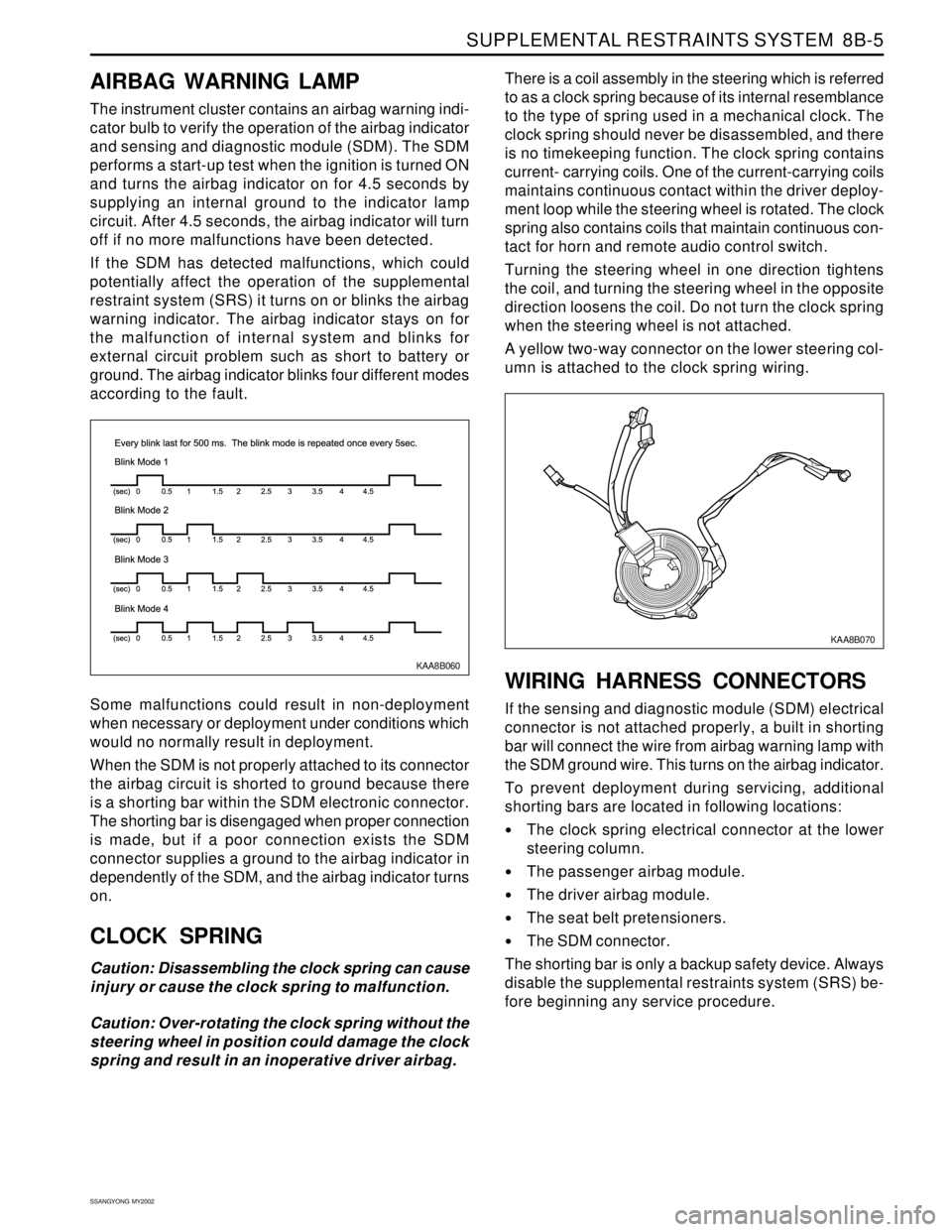
SUPPLEMENTAL RESTRAINTS SYSTEM 8B-5
SSANGYONG MY2002
KAA8B060
AIRBAG WARNING LAMP
The instrument cluster contains an airbag warning indi-
cator bulb to verify the operation of the airbag indicator
and sensing and diagnostic module (SDM). The SDM
performs a start-up test when the ignition is turned ON
and turns the airbag indicator on for 4.5 seconds by
supplying an internal ground to the indicator lamp
circuit. After 4.5 seconds, the airbag indicator will turn
off if no more malfunctions have been detected.
If the SDM has detected malfunctions, which could
potentially affect the operation of the supplemental
restraint system (SRS) it turns on or blinks the airbag
warning indicator. The airbag indicator stays on for
the malfunction of internal system and blinks for
external circuit problem such as short to battery or
ground. The airbag indicator blinks four different modes
according to the fault.
Some malfunctions could result in non-deployment
when necessary or deployment under conditions which
would no normally result in deployment.
When the SDM is not properly attached to its connector
the airbag circuit is shorted to ground because there
is a shorting bar within the SDM electronic connector.
The shorting bar is disengaged when proper connection
is made, but if a poor connection exists the SDM
connector supplies a ground to the airbag indicator in
dependently of the SDM, and the airbag indicator turns
on.
CLOCK SPRING
Caution: Disassembling the clock spring can cause
injury or cause the clock spring to malfunction.
Caution: Over-rotating the clock spring without the
steering wheel in position could damage the clock
spring and result in an inoperative driver airbag.There is a coil assembly in the steering which is referred
to as a clock spring because of its internal resemblance
to the type of spring used in a mechanical clock. The
clock spring should never be disassembled, and there
is no timekeeping function. The clock spring contains
current- carrying coils. One of the current-carrying coils
maintains continuous contact within the driver deploy-
ment loop while the steering wheel is rotated. The clock
spring also contains coils that maintain continuous con-
tact for horn and remote audio control switch.
Turning the steering wheel in one direction tightens
the coil, and turning the steering wheel in the opposite
direction loosens the coil. Do not turn the clock spring
when the steering wheel is not attached.
A yellow two-way connector on the lower steering col-
umn is attached to the clock spring wiring.
WIRING HARNESS CONNECTORS
If the sensing and diagnostic module (SDM) electrical
connector is not attached properly, a built in shorting
bar will connect the wire from airbag warning lamp with
the SDM ground wire. This turns on the airbag indicator.
To prevent deployment during servicing, additional
shorting bars are located in following locations:
The clock spring electrical connector at the lower
steering column.
The passenger airbag module.
The driver airbag module.
The seat belt pretensioners.
The SDM connector.
The shorting bar is only a backup safety device. Always
disable the supplemental restraints system (SRS) be-
fore beginning any service procedure.
KAA8B070
Page 1596 of 2053
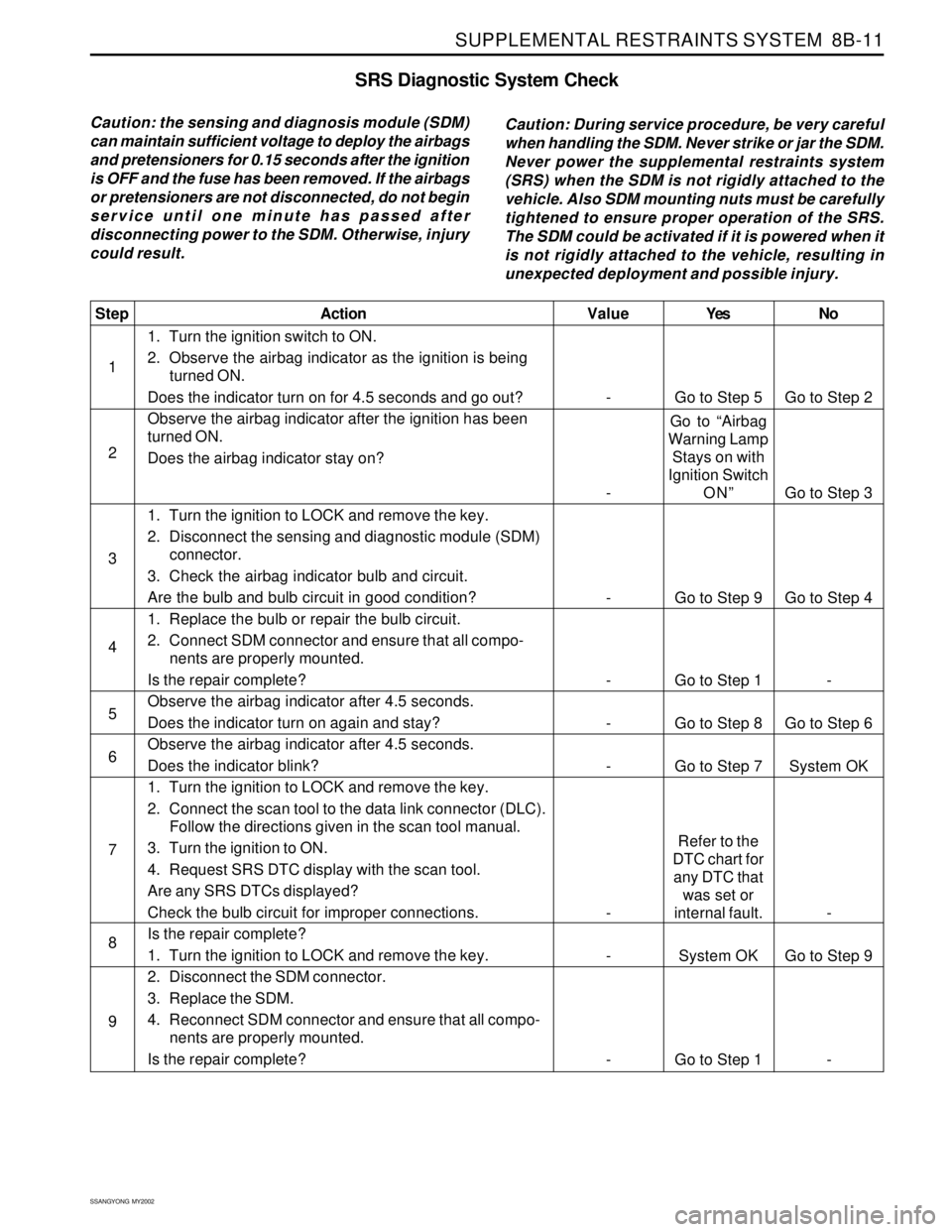
SUPPLEMENTAL RESTRAINTS SYSTEM 8B-11
SSANGYONG MY2002
SRS Diagnostic System Check
Caution: the sensing and diagnosis module (SDM)
can maintain sufficient voltage to deploy the airbags
and pretensioners for 0.15 seconds after the ignition
is OFF and the fuse has been removed. If the airbags
or pretensioners are not disconnected, do not begin
service until one minute has passed after
disconnecting power to the SDM. Otherwise, injury
could result.Caution: During service procedure, be very careful
when handling the SDM. Never strike or jar the SDM.
Never power the supplemental restraints system
(SRS) when the SDM is not rigidly attached to the
vehicle. Also SDM mounting nuts must be carefully
tightened to ensure proper operation of the SRS.
The SDM could be activated if it is powered when it
is not rigidly attached to the vehicle, resulting in
unexpected deployment and possible injury.
Yes
Go to Step 5
Go to “Airbag
Warning Lamp
Stays on with
Ignition Switch
ON”
Go to Step 9
Go to Step 1
Go to Step 8
Go to Step 7
Refer to the
DTC chart for
any DTC that
was set or
internal fault.
System OK
Go to Step 1No
Go to Step 2
Go to Step 3
Go to Step 4
-
Go to Step 6
System OK
-
Go to Step 9
- Value
-
-
-
-
-
-
-
-
-
Step
1
2
3
4
5
6
7
8
9Action
1. Turn the ignition switch to ON.
2. Observe the airbag indicator as the ignition is being
turned ON.
Does the indicator turn on for 4.5 seconds and go out?
Observe the airbag indicator after the ignition has been
turned ON.
Does the airbag indicator stay on?
1. Turn the ignition to LOCK and remove the key.
2. Disconnect the sensing and diagnostic module (SDM)
connector.
3. Check the airbag indicator bulb and circuit.
Are the bulb and bulb circuit in good condition?
1. Replace the bulb or repair the bulb circuit.
2. Connect SDM connector and ensure that all compo-
nents are properly mounted.
Is the repair complete?
Observe the airbag indicator after 4.5 seconds.
Does the indicator turn on again and stay?
Observe the airbag indicator after 4.5 seconds.
Does the indicator blink?
1. Turn the ignition to LOCK and remove the key.
2. Connect the scan tool to the data link connector (DLC).
Follow the directions given in the scan tool manual.
3. Turn the ignition to ON.
4. Request SRS DTC display with the scan tool.
Are any SRS DTCs displayed?
Check the bulb circuit for improper connections.
Is the repair complete?
1. Turn the ignition to LOCK and remove the key.
2. Disconnect the SDM connector.
3. Replace the SDM.
4. Reconnect SDM connector and ensure that all compo-
nents are properly mounted.
Is the repair complete?
Page 1637 of 2053
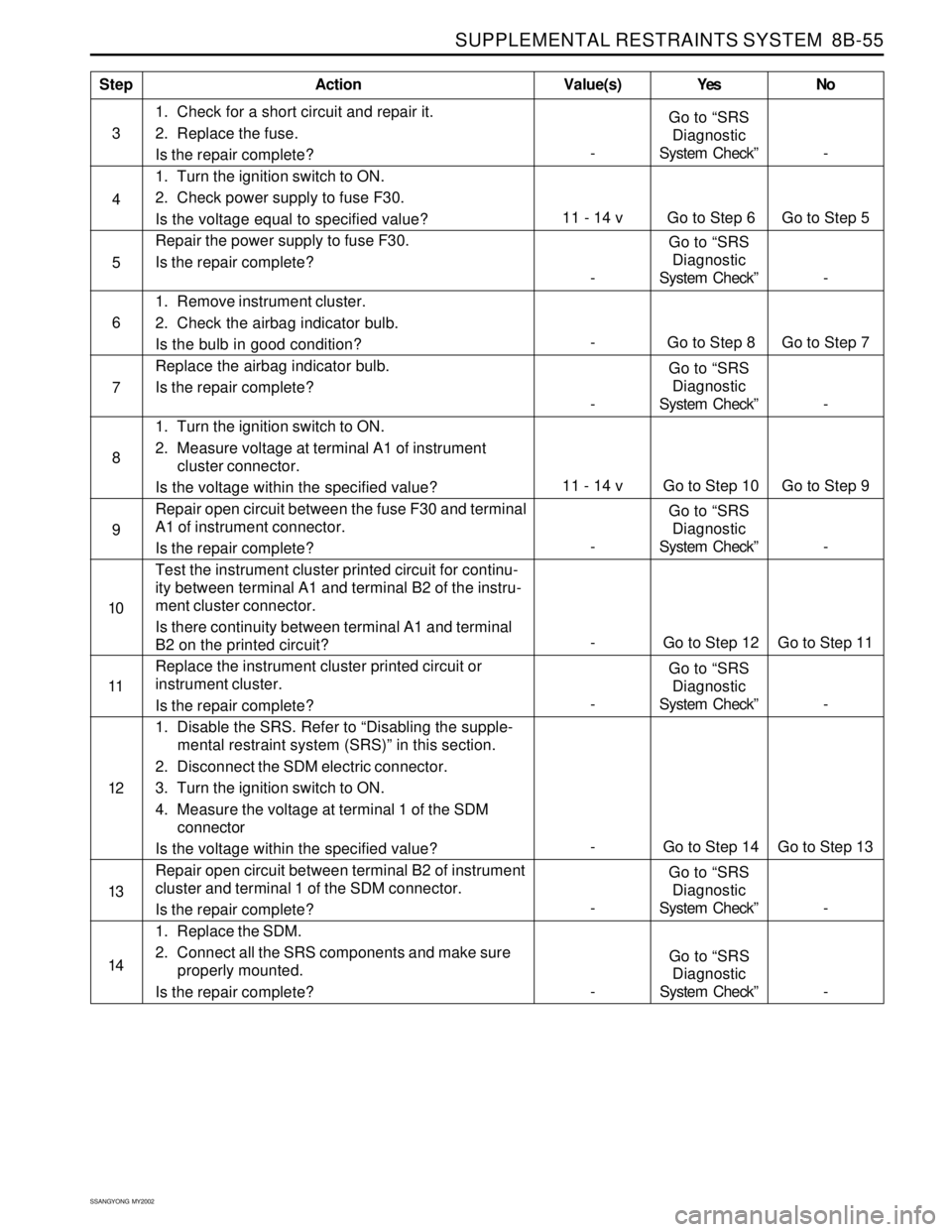
SUPPLEMENTAL RESTRAINTS SYSTEM 8B-55
SSANGYONG MY2002
1. Check for a short circuit and repair it.
2. Replace the fuse.
Is the repair complete?
1. Turn the ignition switch to ON.
2. Check power supply to fuse F30.
Is the voltage equal to specified value?
Repair the power supply to fuse F30.
Is the repair complete?
1. Remove instrument cluster.
2. Check the airbag indicator bulb.
Is the bulb in good condition?
Replace the airbag indicator bulb.
Is the repair complete?
1. Turn the ignition switch to ON.
2. Measure voltage at terminal A1 of instrument
cluster connector.
Is the voltage within the specified value?
Repair open circuit between the fuse F30 and terminal
A1 of instrument connector.
Is the repair complete?
Test the instrument cluster printed circuit for continu-
ity between terminal A1 and terminal B2 of the instru-
ment cluster connector.
Is there continuity between terminal A1 and terminal
B2 on the printed circuit?
Replace the instrument cluster printed circuit or
instrument cluster.
Is the repair complete?
1. Disable the SRS. Refer to “Disabling the supple-
mental restraint system (SRS)” in this section.
2. Disconnect the SDM electric connector.
3. Turn the ignition switch to ON.
4. Measure the voltage at terminal 1 of the SDM
connector
Is the voltage within the specified value?
Repair open circuit between terminal B2 of instrument
cluster and terminal 1 of the SDM connector.
Is the repair complete?
1. Replace the SDM.
2. Connect all the SRS components and make sure
properly mounted.
Is the repair complete?
StepAction Value(s) Yes No
4
6
7
8
11 - 14 v Go to Step 6 Go to Step 5
5
-Go to “SRS
Diagnostic
System Check” -
- Go to Step 8 Go to Step 7
-Go to “SRS
Diagnostic
System Check” -
9
10
11
12
-Go to “SRS
Diagnostic
System Check” - 3
11 - 14 v Go to Step 10 Go to Step 9
-Go to “SRS
Diagnostic
System Check” -
13
- Go to Step 12 Go to Step 11
- Go to Step 14 Go to Step 13
-Go to “SRS
Diagnostic
System Check” -
-Go to “SRS
Diagnostic
System Check” - 14
-Go to “SRS
Diagnostic
System Check” -
Page 1675 of 2053
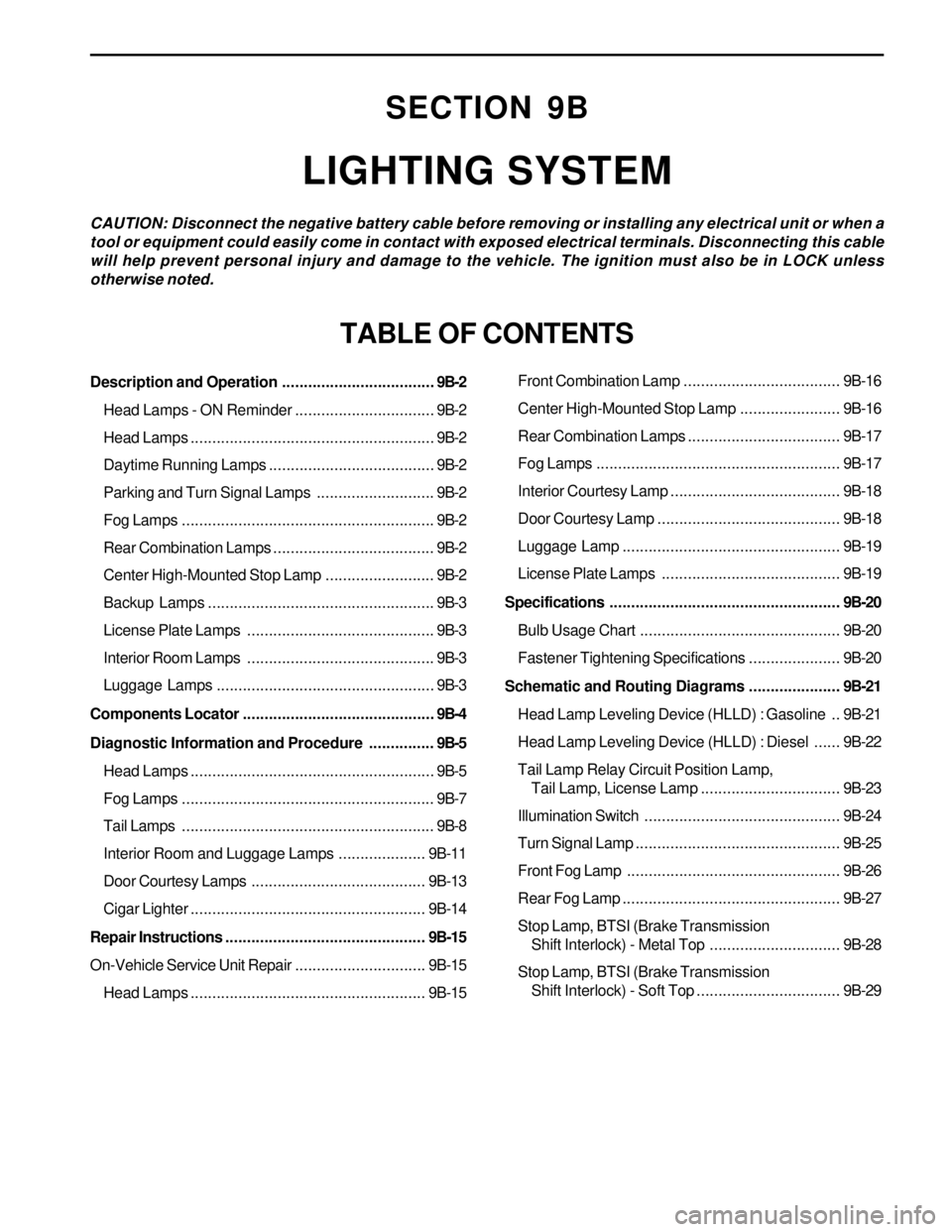
SECTION 9B
LIGHTING SYSTEM
CAUTION: Disconnect the negative battery cable before removing or installing any electrical unit or when a
tool or equipment could easily come in contact with exposed electrical terminals. Disconnecting this cable
will help prevent personal injury and damage to the vehicle. The ignition must also be in LOCK unless
otherwise noted.
TABLE OF CONTENTS
Description and Operation...................................9B-2
Head Lamps - ON Reminder................................9B-2
Head Lamps........................................................9B-2
Daytime Running Lamps......................................9B-2
Parking and Turn Signal Lamps...........................9B-2
Fog Lamps..........................................................9B-2
Rear Combination Lamps.....................................9B-2
Center High-Mounted Stop Lamp.........................9B-2
Backup Lamps....................................................9B-3
License Plate Lamps ...........................................9B-3
Interior Room Lamps ...........................................9B-3
Luggage Lamps..................................................9B-3
Components Locator............................................9B-4
Diagnostic Information and Procedure...............9B-5
Head Lamps........................................................9B-5
Fog Lamps..........................................................9B-7
Tail Lamps..........................................................9B-8
Interior Room and Luggage Lamps....................9B-11
Door Courtesy Lamps ........................................9B-13
Cigar Lighter......................................................9B-14
Repair Instructions..............................................9B-15
On-Vehicle Service Unit Repair..............................9B-15
Head Lamps......................................................9B-15Front Combination Lamp....................................9B-16
Center High-Mounted Stop Lamp.......................9B-16
Rear Combination Lamps...................................9B-17
Fog Lamps........................................................9B-17
Interior Courtesy Lamp .......................................9B-18
Door Courtesy Lamp ..........................................9B-18
Luggage Lamp..................................................9B-19
License Plate Lamps .........................................9B-19
Specifications.....................................................9B-20
Bulb Usage Chart..............................................9B-20
Fastener Tightening Specifications.....................9B-20
Schematic and Routing Diagrams.....................9B-21
Head Lamp Leveling Device (HLLD) : Gasoline ..9B-21
Head Lamp Leveling Device (HLLD) : Diesel......9B-22
Tail Lamp Relay Circuit Position Lamp,
Tail Lamp, License Lamp................................9B-23
Illumination Switch.............................................9B-24
Turn Signal Lamp...............................................9B-25
Front Fog Lamp.................................................9B-26
Rear Fog Lamp..................................................9B-27
Stop Lamp, BTSI (Brake Transmission
Shift Interlock) - Metal Top..............................9B-28
Stop Lamp, BTSI (Brake Transmission
Shift Interlock) - Soft Top.................................9B-29
Page 1676 of 2053
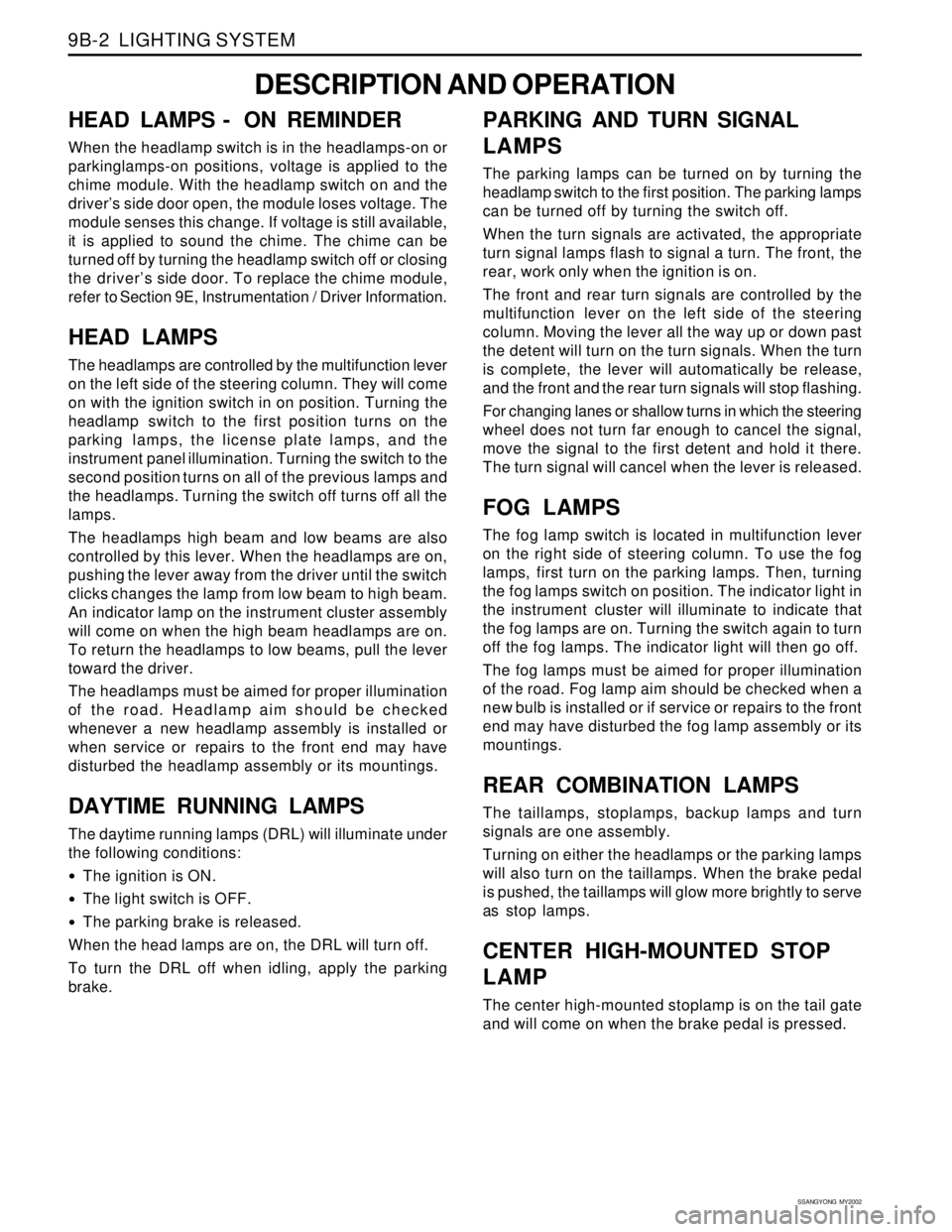
SSANGYONG MY2002
9B-2 LIGHTING SYSTEM
DESCRIPTION AND OPERATION
HEAD LAMPS - ON REMINDER
When the headlamp switch is in the headlamps-on or
parkinglamps-on positions, voltage is applied to the
chime module. With the headlamp switch on and the
driver’s side door open, the module loses voltage. The
module senses this change. If voltage is still available,
it is applied to sound the chime. The chime can be
turned off by turning the headlamp switch off or closing
the driver’s side door. To replace the chime module,
refer to Section 9E, Instrumentation / Driver Information.
HEAD LAMPS
The headlamps are controlled by the multifunction lever
on the left side of the steering column. They will come
on with the ignition switch in on position. Turning the
headlamp switch to the first position turns on the
parking lamps, the license plate lamps, and the
instrument panel illumination. Turning the switch to the
second position turns on all of the previous lamps and
the headlamps. Turning the switch off turns off all the
lamps.
The headlamps high beam and low beams are also
controlled by this lever. When the headlamps are on,
pushing the lever away from the driver until the switch
clicks changes the lamp from low beam to high beam.
An indicator lamp on the instrument cluster assembly
will come on when the high beam headlamps are on.
To return the headlamps to low beams, pull the lever
toward the driver.
The headlamps must be aimed for proper illumination
of the road. Headlamp aim should be checked
whenever a new headlamp assembly is installed or
when service or repairs to the front end may have
disturbed the headlamp assembly or its mountings.
DAYTIME RUNNING LAMPS
The daytime running lamps (DRL) will illuminate under
the following conditions:
The ignition is ON.
The light switch is OFF.
The parking brake is released.
When the head lamps are on, the DRL will turn off.
To turn the DRL off when idling, apply the parking
brake.
PARKING AND TURN SIGNAL
LAMPS
The parking lamps can be turned on by turning the
headlamp switch to the first position. The parking lamps
can be turned off by turning the switch off.
When the turn signals are activated, the appropriate
turn signal lamps flash to signal a turn. The front, the
rear, work only when the ignition is on.
The front and rear turn signals are controlled by the
multifunction lever on the left side of the steering
column. Moving the lever all the way up or down past
the detent will turn on the turn signals. When the turn
is complete, the lever will automatically be release,
and the front and the rear turn signals will stop flashing.
For changing lanes or shallow turns in which the steering
wheel does not turn far enough to cancel the signal,
move the signal to the first detent and hold it there.
The turn signal will cancel when the lever is released.
FOG LAMPS
The fog lamp switch is located in multifunction lever
on the right side of steering column. To use the fog
lamps, first turn on the parking lamps. Then, turning
the fog lamps switch on position. The indicator light in
the instrument cluster will illuminate to indicate that
the fog lamps are on. Turning the switch again to turn
off the fog lamps. The indicator light will then go off.
The fog lamps must be aimed for proper illumination
of the road. Fog lamp aim should be checked when a
new bulb is installed or if service or repairs to the front
end may have disturbed the fog lamp assembly or its
mountings.
REAR COMBINATION LAMPS
The taillamps, stoplamps, backup lamps and turn
signals are one assembly.
Turning on either the headlamps or the parking lamps
will also turn on the taillamps. When the brake pedal
is pushed, the taillamps will glow more brightly to serve
as stop lamps.
CENTER HIGH-MOUNTED STOP
LAMP
The center high-mounted stoplamp is on the tail gate
and will come on when the brake pedal is pressed.
Page 1677 of 2053
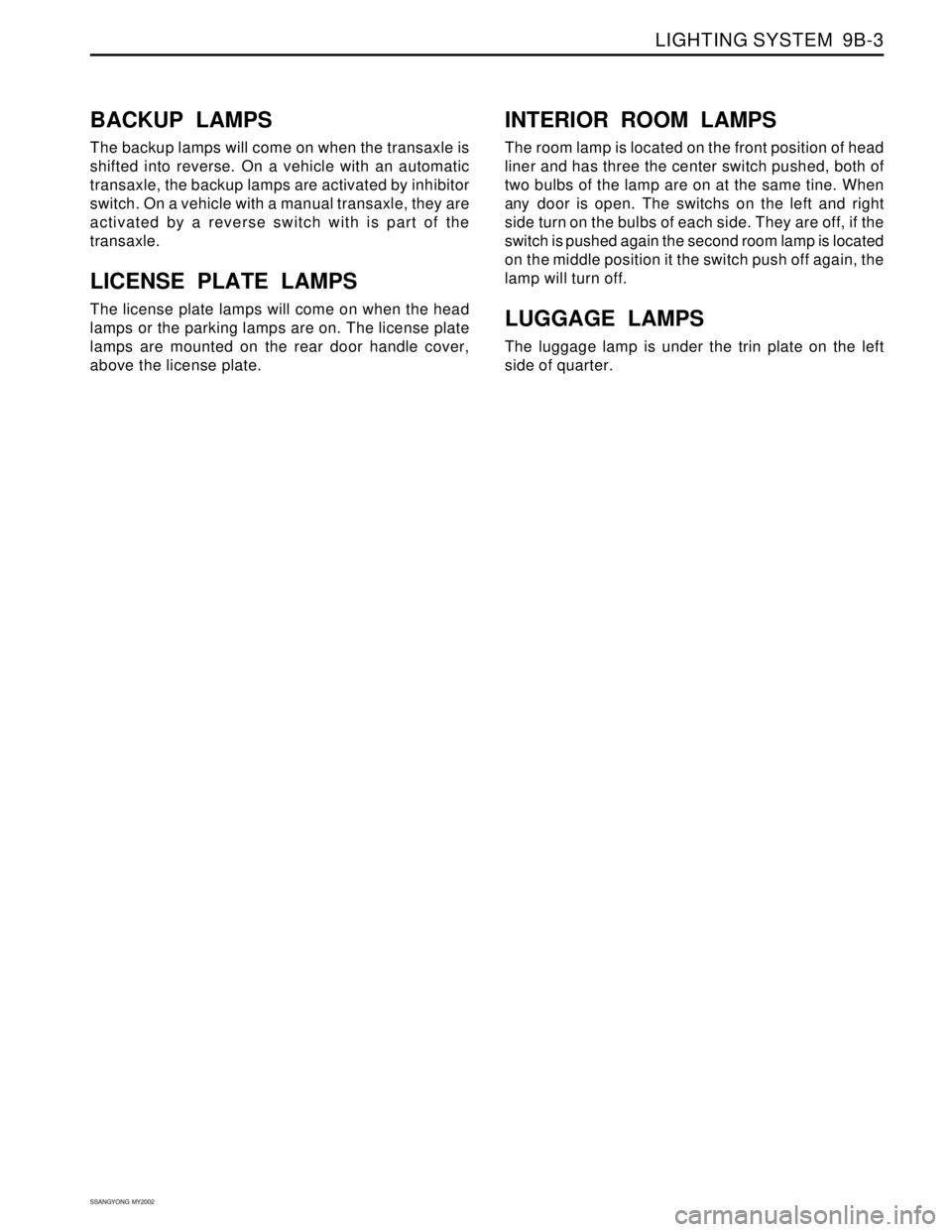
LIGHTING SYSTEM 9B-3
SSANGYONG MY2002
BACKUP LAMPS
The backup lamps will come on when the transaxle is
shifted into reverse. On a vehicle with an automatic
transaxle, the backup lamps are activated by inhibitor
switch. On a vehicle with a manual transaxle, they are
activated by a reverse switch with is part of the
transaxle.
LICENSE PLATE LAMPS
The license plate lamps will come on when the head
lamps or the parking lamps are on. The license plate
lamps are mounted on the rear door handle cover,
above the license plate.
INTERIOR ROOM LAMPS
The room lamp is located on the front position of head
liner and has three the center switch pushed, both of
two bulbs of the lamp are on at the same tine. When
any door is open. The switchs on the left and right
side turn on the bulbs of each side. They are off, if the
switch is pushed again the second room lamp is located
on the middle position it the switch push off again, the
lamp will turn off.
LUGGAGE LAMPS
The luggage lamp is under the trin plate on the left
side of quarter.
Page 1681 of 2053

LIGHTING SYSTEM 9B-7
SSANGYONG MY2002
Step
1
2
3
4
5
6
7
8
9
10
11
12
13
14
15Action
Check fuse EF12.
Is EF12 blown.
1. Check for a short circuit and repair it, if
necessary.
2. Replace the fuse.
Is the repair complete?
Use a voltmeter or test lamp to check fuse EF12.
Does the battery voltage available at fuse EF12 equal
the specified value?
Repair the open circuit from the battery to fuse EF12.
Is the repair complete?
Remove the fog lamp relay and temporarily substitute
a known good relay such as the headlamp relay or the
illumination lamp relay.
1. Return the substituted relay to its original position.
2. Replace the inoperative fog lamp relay.
Is the repair complete?
1. Return the substituted relay to its original position,
but do not reinstall the fog lamp relay.
2. Using a voltmeter or test lamp, check the fog lamp
relay socket terminal 30.
Does the battery voltage available at the fog lamp
relay socket equal the specified value?
Repair the open circuit between fuse EF12 and the fog
lamp relay.
Is the repair complete?
At the fog lamp relay socket, use an ohmmeter or test
lamp to verify that the connector for relay terminal 85
is connected to ground.
Does the resistance equal the specified value?
Repair the ground circuit for the fog lamp relay.
Is the repair complete?
With the fog lamp relay reinstalled and the switch on,
test for voltage at the fog lamp connector.
Does the battery voltage available at the fog lamp
connector equal the specified value?
Repair the open circuit between the fog lamp relay
terminal 87 and the fog lamps.
Is the repair complete?
Use an ohmmeter or test lamp to check the ground at
the ground side of the fog lamp connector.
Does the resistance equal the specified value?
Repair the fog lamp ground circuit.
Is the repair complete?
Replace the faulty fog lamp bulbs.Is the repair
complete?Yes
Go to Step 2
System OK
Go to Step 5
System OK
Go to Step 6
System OK
Go to Step 9
System OK
Go to Step 11
System OK
Go to Step 13
System OK
Go to Step 15
System OK
System OKNo
Go to Step 3
-
Go to Step 4
-
Go to Step 7
-
Go to Step 8
-
Go to Step 10
-
Go to Step 12
-
Go to Step 14
-
- Value(s)
-
-
11 - 14 v
-
-
-
11 - 14 v
-
0 Ω
-
11 - 14 v
-
0 Ω
-
-
FOG LAMPS
Fog Lamps Inoperative
Page 1682 of 2053
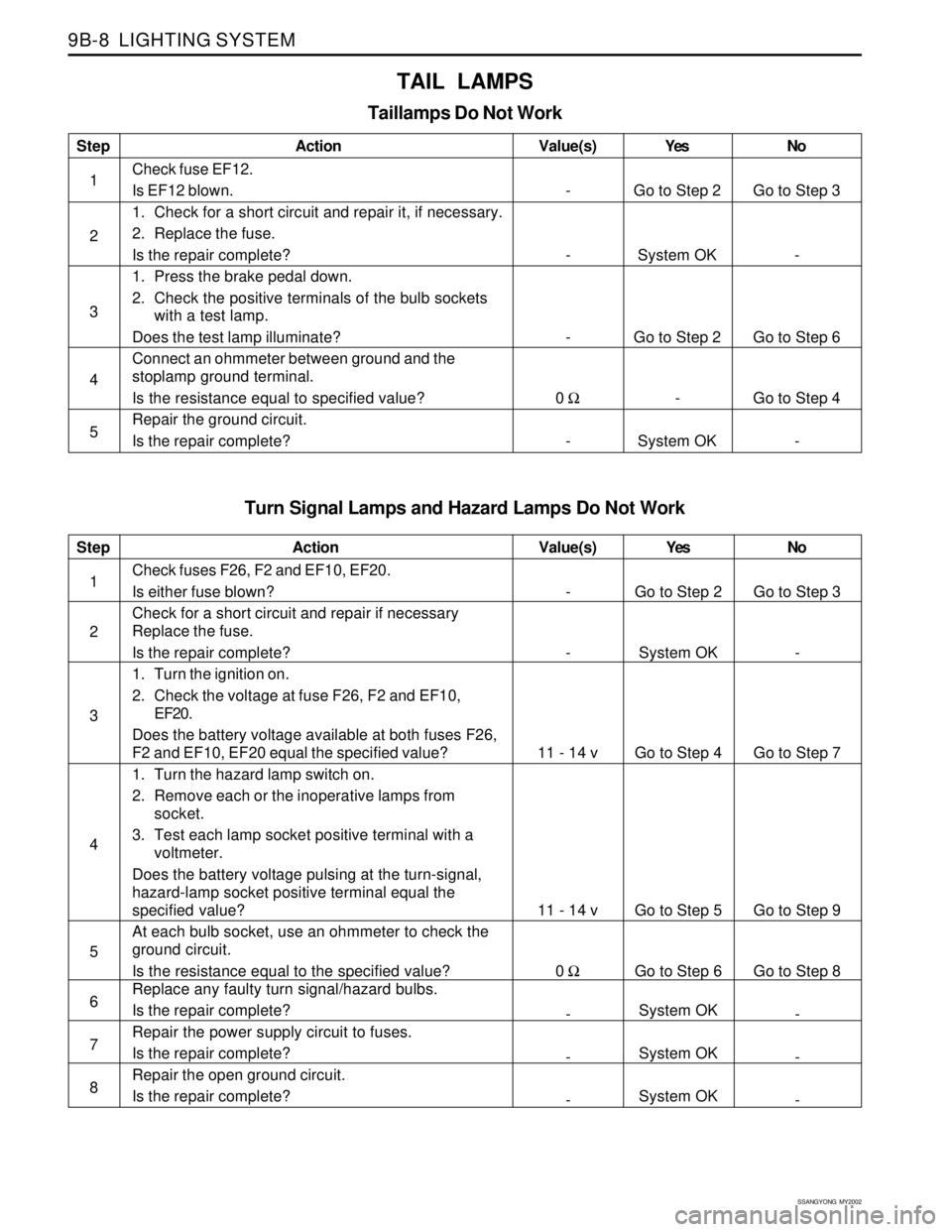
SSANGYONG MY2002
9B-8 LIGHTING SYSTEM
Turn Signal Lamps and Hazard Lamps Do Not Work
Step
1
2
3
4
5
6
7
8Action
Check fuses F26, F2 and EF10, EF20.
Is either fuse blown?
Check for a short circuit and repair if necessary
Replace the fuse.
Is the repair complete?
1. Turn the ignition on.
2. Check the voltage at fuse F26, F2 and EF10,
EF20.
Does the battery voltage available at both fuses F26,
F2 and EF10, EF20 equal the specified value?
1. Turn the hazard lamp switch on.
2. Remove each or the inoperative lamps from
socket.
3. Test each lamp socket positive terminal with a
voltmeter.
Does the battery voltage pulsing at the turn-signal,
hazard-lamp socket positive terminal equal the
specified value?
At each bulb socket, use an ohmmeter to check the
ground circuit.
Is the resistance equal to the specified value?
Replace any faulty turn signal/hazard bulbs.
Is the repair complete?
Repair the power supply circuit to fuses.
Is the repair complete?
Repair the open ground circuit.
Is the repair complete?Yes
Go to Step 2
System OK
Go to Step 4
Go to Step 5
Go to Step 6
System OK
System OK
System OKNo
Go to Step 3
-
Go to Step 7
Go to Step 9
Go to Step 8
-
-
- Value(s)
-
-
11 - 14 v
11 - 14 v
0 Ω
-
-
-
TAIL LAMPS
Taillamps Do Not Work
Step
1
2
3
4
5Action
Check fuse EF12.
Is EF12 blown.
1. Check for a short circuit and repair it, if necessary.
2. Replace the fuse.
Is the repair complete?
1. Press the brake pedal down.
2. Check the positive terminals of the bulb sockets
with a test lamp.
Does the test lamp illuminate?
Connect an ohmmeter between ground and the
stoplamp ground terminal.
Is the resistance equal to specified value?
Repair the ground circuit.
Is the repair complete?Yes
Go to Step 2
System OK
Go to Step 2
-
System OKNo
Go to Step 3
-
Go to Step 6
Go to Step 4
- Value(s)
-
-
-
0 Ω
-